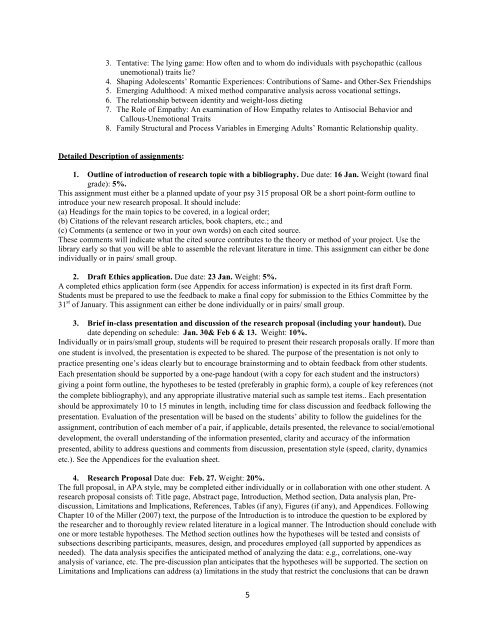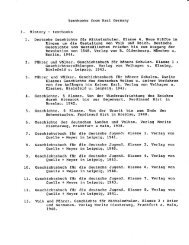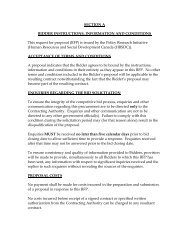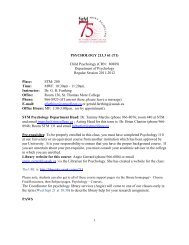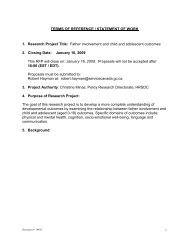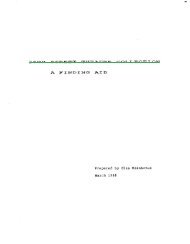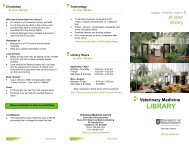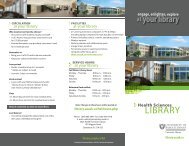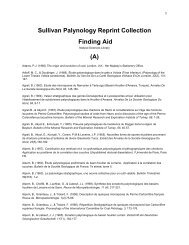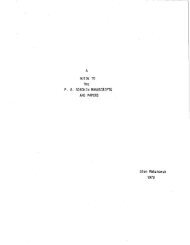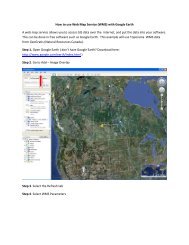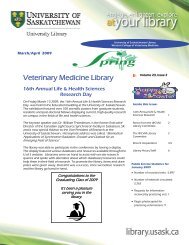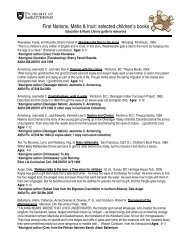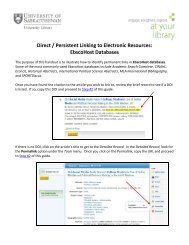St. Thomas More College, University of Saskatchewan Department ...
St. Thomas More College, University of Saskatchewan Department ...
St. Thomas More College, University of Saskatchewan Department ...
You also want an ePaper? Increase the reach of your titles
YUMPU automatically turns print PDFs into web optimized ePapers that Google loves.
3. Tentative: The lying game: How <strong>of</strong>ten and to whom do individuals with psychopathic (callous<br />
unemotional) traits lie?<br />
4. Shaping Adolescents’ Romantic Experiences: Contributions <strong>of</strong> Same- and Other-Sex Friendships<br />
5. Emerging Adulthood: A mixed method comparative analysis across vocational settings.<br />
6. The relationship between identity and weight-loss dieting<br />
7. The Role <strong>of</strong> Empathy: An examination <strong>of</strong> How Empathy relates to Antisocial Behavior and<br />
Callous-Unemotional Traits<br />
8. Family <strong>St</strong>ructural and Process Variables in Emerging Adults’ Romantic Relationship quality.<br />
Detailed Description <strong>of</strong> assignments:<br />
1. Outline <strong>of</strong> introduction <strong>of</strong> research topic with a bibliography. Due date: 16 Jan. Weight (toward final<br />
grade): 5%.<br />
This assignment must either be a planned update <strong>of</strong> your psy 315 proposal OR be a short point-form outline to<br />
introduce your new research proposal. It should include:<br />
(a) Headings for the main topics to be covered, in a logical order;<br />
(b) Citations <strong>of</strong> the relevant research articles, book chapters, etc.; and<br />
(c) Comments (a sentence or two in your own words) on each cited source.<br />
These comments will indicate what the cited source contributes to the theory or method <strong>of</strong> your project. Use the<br />
library early so that you will be able to assemble the relevant literature in time. This assignment can either be done<br />
individually or in pairs/ small group.<br />
2. Draft Ethics application. Due date: 23 Jan. Weight: 5%.<br />
A completed ethics application form (see Appendix for access information) is expected in its first draft Form.<br />
<strong>St</strong>udents must be prepared to use the feedback to make a final copy for submission to the Ethics Committee by the<br />
31 st <strong>of</strong> January. This assignment can either be done individually or in pairs/ small group.<br />
3. Brief in-class presentation and discussion <strong>of</strong> the research proposal (including your handout). Due<br />
date depending on schedule: Jan. 30& Feb 6 & 13. Weight: 10%.<br />
Individually or in pairs/small group, students will be required to present their research proposals orally. If more than<br />
one student is involved, the presentation is expected to be shared. The purpose <strong>of</strong> the presentation is not only to<br />
practice presenting one’s ideas clearly but to encourage brainstorming and to obtain feedback from other students.<br />
Each presentation should be supported by a one-page handout (with a copy for each student and the instructors)<br />
giving a point form outline, the hypotheses to be tested (preferably in graphic form), a couple <strong>of</strong> key references (not<br />
the complete bibliography), and any appropriate illustrative material such as sample test items.. Each presentation<br />
should be approximately 10 to 15 minutes in length, including time for class discussion and feedback following the<br />
presentation. Evaluation <strong>of</strong> the presentation will be based on the students’ ability to follow the guidelines for the<br />
assignment, contribution <strong>of</strong> each member <strong>of</strong> a pair, if applicable, details presented, the relevance to social/emotional<br />
development, the overall understanding <strong>of</strong> the information presented, clarity and accuracy <strong>of</strong> the information<br />
presented, ability to address questions and comments from discussion, presentation style (speed, clarity, dynamics<br />
etc.). See the Appendices for the evaluation sheet.<br />
4. Research Proposal Date due: Feb. 27. Weight: 20%.<br />
The full proposal, in APA style, may be completed either individually or in collaboration with one other student. A<br />
research proposal consists <strong>of</strong>: Title page, Abstract page, Introduction, Method section, Data analysis plan, Prediscussion,<br />
Limitations and Implications, References, Tables (if any), Figures (if any), and Appendices. Following<br />
Chapter 10 <strong>of</strong> the Miller (2007) text, the purpose <strong>of</strong> the Introduction is to introduce the question to be explored by<br />
the researcher and to thoroughly review related literature in a logical manner. The Introduction should conclude with<br />
one or more testable hypotheses. The Method section outlines how the hypotheses will be tested and consists <strong>of</strong><br />
subsections describing participants, measures, design, and procedures employed (all supported by appendices as<br />
needed). The data analysis specifies the anticipated method <strong>of</strong> analyzing the data: e.g., correlations, one-way<br />
analysis <strong>of</strong> variance, etc. The pre-discussion plan anticipates that the hypotheses will be supported. The section on<br />
Limitations and Implications can address (a) limitations in the study that restrict the conclusions that can be drawn<br />
5


